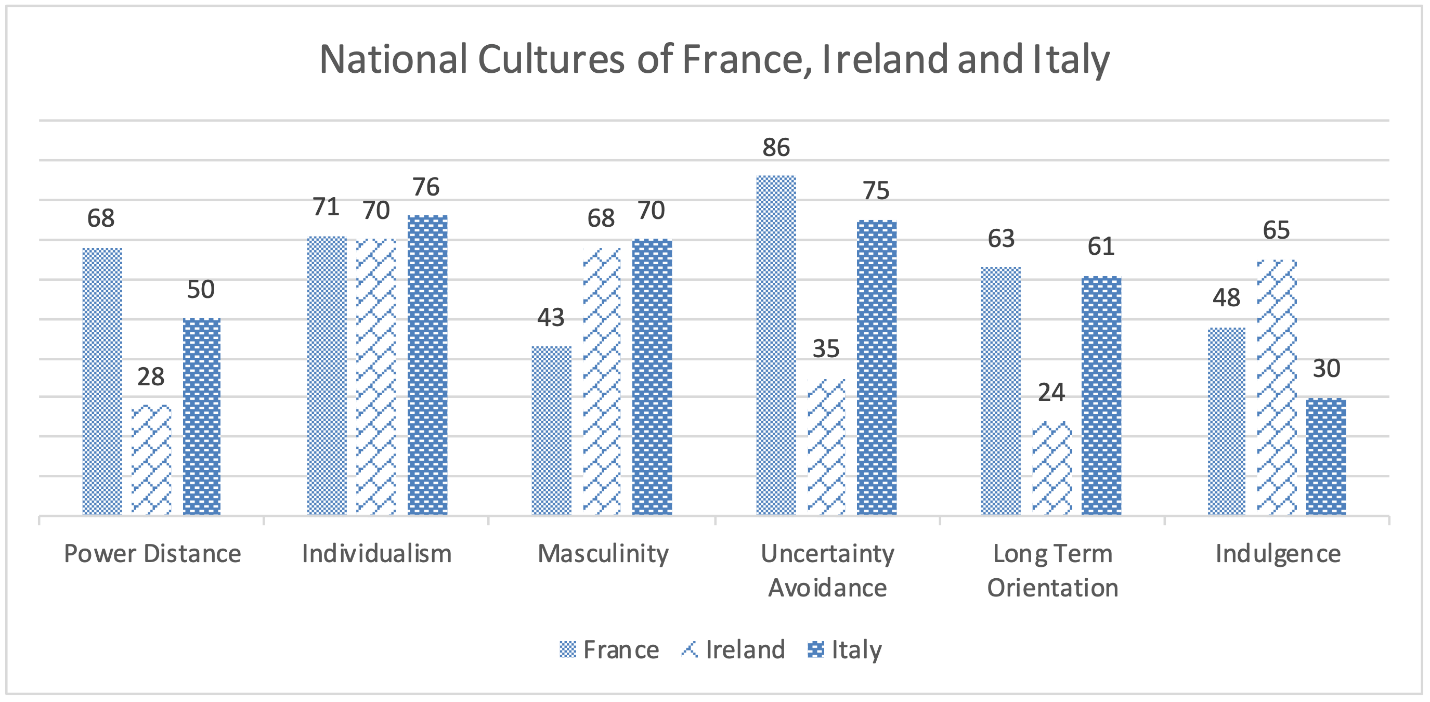It seems reasonable to claim that France, Italy and Ireland have a number of substantial differences within the cultural scope. These differences affect the functioning of any establishment, company or activity. Such peculiarities are to be taken into account to define, for instance, how HR practices should be changed if a plant is to be opened in either France or Italy – not in Ireland. In order to provide exhaustive suggestions on the latter example, it might be rational to apply Hofstede’s National Cultures comparison tool.
According to the tool’s indicators, Ireland has the lowest power distancing rate (28) if to compare with France (68) and Italy (50). It means that in Ireland, less powerful personnel accept the fact that power is distributed unequally. Then, the extent of individualism tends to vary insignificantly – with 71 for France, 70 for Ireland and 76 for Italy. It means that societies of these countries do not tend to maintain the interdependence within their structures. Individuals would rather care about themselves and their families at first.
Furthermore, Ireland and Italy demonstrate approximately the same degree of masculinity, with the scores of 68 and 70, respectively; in contrast, France has 43 scores and may be defined as a feminine country. The primary point here is that in masculine societies, people are motived by the aspiration to be the best, while in feminine ones by liking what they do. Then, uncertainty avoidance reveals the fact that France and Italy – with the rates of 86 and 75, respectively – tend to attempt to control the future, feeling threatened by unknown situations. Here, Ireland shows the lowest score of 35, which indicates that the society is confident in its future.
Ireland also demonstrates the lowest rate of long-term orientation – 24; it means that Irish society is a normative one that honours traditions and tries avoiding any societal change. In this regard, France has the rate of 63 and Italy has 61, which shows that the French and Italians maintain efforts in modern education to get ready for the future. Finally, the indulgence rates are as follows: Ireland has 65, France – 48 and Italy – 30. This might prove the fact that the Irish tend to control their wishes and impulses to a great extent, while Italians do not. Given the cultural features above, it seems possible to formulate the suggestions of three HR practices that should be changed if a plant will be operating in France or Italy.
The first recommendation will refer to the management of the teams. As claimed above, France and Italy have higher rates of power distancing if to compare with Ireland. Thus, in France and Italy, it is essential to provide working groups with more equal opportunities to organise their working processes than in Ireland. The second suggestion would be to give more possibilities to employees for gaining new relevant skills. It is justified by the fact that Ireland has the lowest score of long-term orientation and avoids any changes within established aspects, such as education. The third proposition is to allow staff to affect a working environment according to their wishes to an exact extent as France and Italy have lower rates of indulgence than Ireland.
To conclude, Hofstede’s National Cultures comparison tool confirmed that the three abovementioned countries have a number of cultural features that affect any activity. The most significant differences refer to power distance, long-term orientation and indulgence. The suggestions on HR practices that were provided are related to these differences directly. There might be several substantial changes while adapting HR policies in Ireland to the French and Italian cultural peculiarities.
